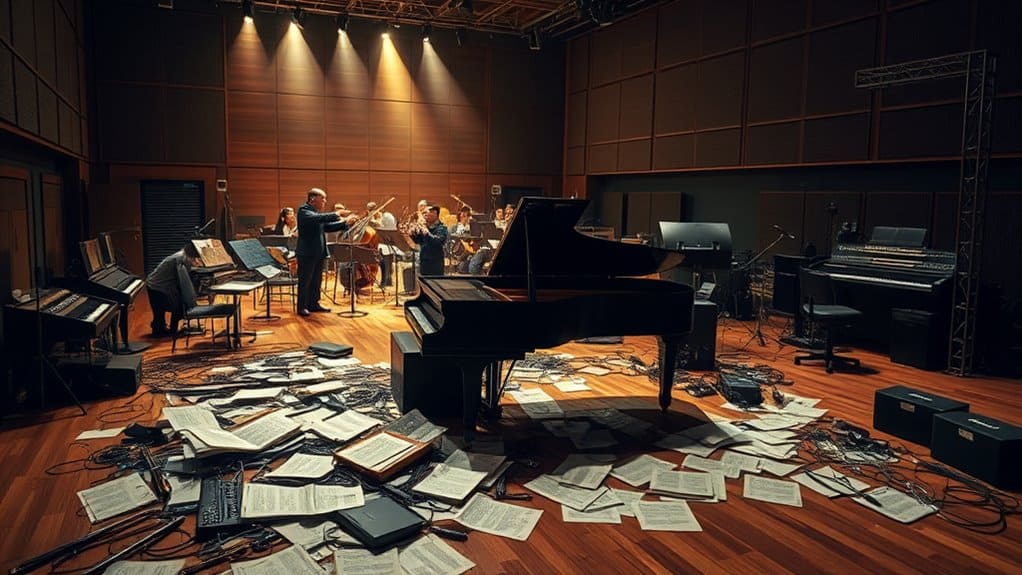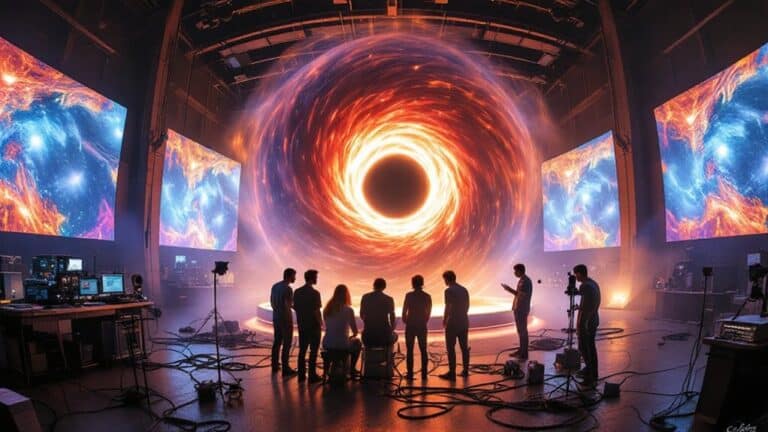Hans Zimmer’s Interstellar Score: How Music Drives the Film’s Emotional Core
Hans Zimmer’s score for *Interstellar* isn’t just background music; it’s a fundamental layer that drives the film’s emotional core. By blending minimalist techniques with Romantic elements, Zimmer creates an expansive soundscape that mirrors the characters’ profound journeys. Unique instrumentation, including an iconic pipe organ and a 60-voice choir, further elevates the emotional gravity, while careful recording choices capture a haunting intimacy. As you experience the score’s dynamics—oscillating between tension and release—you’re drawn deeper into familial bonds and the essence of longing. Each note resonates, inviting you to explore how sound shapes this cinematic narrative’s heart and soul.
Table of Contents
Key Takeaways
- The score blends minimalism and Romanticism, creating a vast emotional landscape that mirrors the characters’ journeys throughout the film.
- Unique instrumentation, including a 90-year-old pipe organ, adds both grandeur and intimacy, enhancing the film’s emotional depth.
- Emotional layering through strings, solo piano, and choir performances evokes feelings of longing and connection among characters.
- Innovative recording techniques, like distant miking, capture reverberations that enrich the score’s atmosphere and emotional resonance.
- The score serves as the film’s emotional glue, grounding audiences in the narrative and enhancing themes of familial bonds and longing.
Unique Composition Techniques
Hans Zimmer employs a variety of unique composition techniques in the “Interstellar” score that set it apart from traditional film music. One standout feature is his use of experimental instrumentation, such as a 90-year-old pipe organ, which creates a majestic, awe-inspiring sound that resonates deeply.
You’ll notice how woodwind players are encouraged to explore unusual sounds, adding an element of surprise and intrigue. The score also includes a 60-voice mixed choir, often recorded facing away from microphones, resulting in a haunting, distant quality that evokes a sense of longing. Zimmer skillfully incorporates emotional layering throughout the score. By focusing on strings and solo performances, he guarantees that intimate moments shine amidst the vastness of space. This is further enhanced by the use of a wide range of instrumentation, which contributes to the overall emotional impact.
His use of pedal points and ostinatos builds tension, while large reverb effects create an expansive atmosphere. In tracks like “Coward” and “No Time for Caution,” he masterfully balances silence with orchestral swells, leaving you breathless. Additionally, the central instrument—a 90-year-old pipe organ—adds a profound historical significance to the score. Notably, the score serves as an integral narrative language that elevates the cinematic experience and invites audiences to engage on a deeper emotional level.
These techniques contribute to a cosmic symphony that doesn’t just accompany the film; it immerses you in its emotional core, inviting you to feel and reflect on your own experiences.
Thematic Elements of the Score

The thematic elements of “Interstellar’s” score blend minimalism and Romanticism to create an enthralling soundscape that resonates with audiences. This fusion enhances the emotional resonance of the film, intertwining repetitive cellular ideas with evocative melodic motifs.
By employing minimalist techniques, such as ostinatos and repetitive patterns, Zimmer crafts a sense of vastness and timelessness, perfectly mirroring the film’s exploration of space. The score, composed by Hans Zimmer, showcases his unique instrumentation that enhances emotional depth, which is particularly evident in the film’s strong performances from key actors. The score took two years to develop after the initial theme was approved, highlighting Zimmer’s dedication to capturing the film’s essence.
The Romantic elements enrich the score, adding depth and emotional complexity, allowing you to forge thematic connections with the characters’ journeys. You can feel the power of the 60-person choir, which elevates the music, transforming it into an experience that deeply connects with your soul.
The piano’s prominent role in the four-note ostinato evokes feelings of innocence and longing, while strings and organ amplify the drama and spirituality of the narrative.
Zimmer’s mastery of thematic motifs creates a cohesive musical narrative that reflects family bonds and humanity’s connection to the cosmos. Each element interweaves seamlessly, forging an emotional core that invites you to engage with the film on a profoundly personal level, evoking feelings of wonder and belonging.
Motional and Emotional Impact

Many viewers find that the emotional impact of “Interstellar’s” score transcends traditional film music, deeply enhancing their connection to the story. Hans Zimmer’s composition elevates storytelling, weaving emotional resonance through each scene, allowing you to feel the weight of love, sacrifice, and resilience.
As the film unfolds, the music creates powerful connections between characters and their journeys, inviting you into an immersive cinematic experience. The 60-person choir adds an ethereal quality, pulling at your heartstrings as it echoes themes of exploration and human connection.
With innovative instrumentation like the pipe organ and synthesizers, you’re drawn into a soundscape that feels both futuristic and familiar. The repetitive patterns and minimalistic approaches enhance the emotional depth, making moments of loss and longing resonate profoundly. The score’s structure also reflects the film’s themes of human bonding, particularly in parent-child relationships. Zimmer’s use of unique instruments further amplifies the vastness of space, creating an atmosphere that enhances the film’s narrative.
More than just background noise, the score acts as a storytelling tool, guiding you through the vastness of the universe while grounding you in the intimate struggles of its characters.
Ultimately, Zimmer’s work sets a new standard for film soundtracks, reminding you of the powerful role music plays in shaping our emotional landscape.
Recording and Production Insights

When you explore the recording and production insights of Hans Zimmer’s *Interstellar* score, you uncover a fascinating blend of unique locations and intricate ensemble details.
The choice of Temple Church, with its majestic organ, along with a carefully crafted group of musicians, showcases Zimmer’s deep creative involvement and dedication to achieving a sound that resonates emotionally. This was further exemplified by the use of a 1926 Harrison & Harrison organ, which reflects both the vastness of space and the intimate moments of the film. The incorporation of live orchestration adds an authentic depth to the score, enhancing its emotional impact on the audience. Zimmer’s use of Morse code within rhythmic patterns cleverly mirrors the film’s themes of time perception and urgency.
Each decision, from the recording techniques to the ensemble composition, reflects not just technical precision but also a profound connection to the film’s themes, inviting you to appreciate the artistry behind this monumental score.
Unique Recording Locations
Utilizing unique recording locations, Hans Zimmer crafted a score for *Interstellar* that resonates with both grandeur and intimacy. One of the standout sites was Temple Church, where the majestic 1926 four-manual Harrison & Harrison organ came to life. With its 3,828 pipes, the organ delivered a bright sound that echoed the film’s themes, evoking the roar of spaceship afterburners and the preciousness of air for astronauts. The score features an ensemble that included 34 strings, 24 woodwinds, showcasing the depth of orchestration Zimmer employed.
The recording atmosphere in this historic space enhanced the emotional depth of the music, allowing Zimmer to capture the essence of the film’s narrative. Notably, this score took two years to complete, showcasing Zimmer’s meticulous craftsmanship.
At both Temple Church and AIR Lyndhurst Hall, various miking setups played a vital role in the process. Engineers experimented with distances, placing microphones both 20 and 40 feet away to capture the organ’s rich, reverberant sound.
As Zimmer composed the score in parallel with the film’s development, these locations provided a sense of belonging, merging the physical environment with the emotional core of the story. Through these unique choices, Zimmer not only shaped the film’s soundscape but also connected deeply with audiences, inviting them into a world where music and emotion intertwine seamlessly.
Ensemble Composition Details
With a diverse ensemble composition, Hans Zimmer’s score for *Interstellar* showcases a rich tapestry of sound that enhances the film’s emotional and thematic depth. The careful selection of instrumental elements, combined with innovative recording techniques, creates a unique auditory experience that resonates with your heart. The score features a 60-voice mixed choir, which elevates the overall sound landscape and adds to the film’s emotional weight. The music also emphasizes the theme of time running out, creating a palpable sense of urgency throughout the film.
The ensemble dynamics come alive with a blend of strings, woodwinds, and a powerful choir, all contributing to a sense of vastness and intimacy.
- 34 strings and 24 woodwinds provide a lush foundation.
- The iconic organ, recorded in Temple Church, adds a celestial quality.
- Solo performances on piano and harp evoke personal connection.
- Choir members singing away from microphones create ethereal textures.
- Electronic effects in tracks like “A Place Among the Stars” heighten atmosphere.
This instrumentation variety not only drives the film’s narrative but also invites you to reflect on its emotional core.
The striking contrasts between delicate solos and full orchestral swells mirror the film’s themes of love, sacrifice, and exploration. Each note feels intentional, drawing you into the story while allowing you to ponder your own place in the universe.
Zimmer’s artistry in composition reveals how music can truly elevate cinematic experiences.
Zimmer’s Creative Involvement
Hans Zimmer’s creative involvement in crafting the *Interstellar* score reveals a meticulous approach to recording and production that deeply enriched the film’s emotional landscape.
From the outset, Zimmer embraced a collaborative process with Christopher Nolan, who provided him with a short story that sparked the initial composition. This creative freedom allowed Zimmer to explore unique sounds and instrumentation, ultimately leading to a score that feels both innovative and deeply connected to the film’s themes.
Recording sessions took place in iconic locations like AIR Lyndhurst Hall and Temple Church, where Zimmer used thoughtful microphone placements to capture the organ’s rich dynamics.
Many tracks featured live performances, infusing authenticity into the music. Techniques such as instructing woodwind players to produce unusual sounds and managing natural reverb through extended shots enhanced the score’s emotional depth.
The final product emerged from two years of dedicated craftsmanship, blending acoustic and electronic elements seamlessly.
Zimmer’s ability to experiment, alongside Nolan’s trust in his vision, culminated in a score that resonates profoundly with audiences, leaving a lasting impression on the film’s emotional core.
This collaboration not only shaped the film but also solidified Zimmer’s legacy as a composer.
Innovations and Influences on the Score

While exploring the depths of space and the complexities of human emotion, the innovations in Hans Zimmer’s score for *Interstellar* redefine how film music can resonate with audiences. His approach embodies musical experimentation, blending traditional orchestral elements with modern sounds.
The score’s evolution is evident in its unique composition process, where Zimmer crafted a poignant four-minute piano piece in just one night, inspired by themes of fatherhood.
- The use of a 1926 pipe organ adds a unique, otherworldly quality.
- Minimalist techniques create a sense of vastness and fragility.
- Zimmer’s collaboration with physicist Kip Thorne guarantees scientific accuracy in sound representation.
- A mixed choir of 60 voices elevates the emotional depth of the score.
- The integration of synthesizers and electronic elements enhances the futuristic feel.
This innovative soundscape not only immerses you in the film’s narrative but also resonates with profound themes of love, loss, and cosmic exploration.
Critical Reception and Acclaim

*Interstellar’s* score garnered nearly universal acclaim, highlighting its intellectual depth and emotional resonance. Critics and audiences alike praised its thematic coherence and emotional impact, making it a standout in modern film scores. With 44 wins, including an Oscar nomination for Best Original Score, it’s clear that Zimmer’s work struck a chord.
| Aspect | Praise | Criticism |
|---|---|---|
| Intellectual Approach | High praise for thematic consistency | Some found it slow and lacking complexity |
| Emotional Resonance | Evokes deep feelings and enhances narratives | Minimal piano work critiqued for resonance |
| Community Feedback | Widely approved by film score enthusiasts | Comparisons to Vangelis noted for simplicity |
Through critical analysis, many noted Zimmer’s unique orchestration choices, like the minimal use of brass and the incorporation of a 60-person choir, which created a profound experience. Audience feedback reflects a strong connection to the music, engaging listeners on a deeper level. Ultimately, the score’s legacy continues to influence film music, reinforcing its place within cinematic history.
The Score’s Role in Narrative

In *Interstellar*, the score plays an essential role in shaping the narrative, weaving emotional threads that connect characters and events.
Hans Zimmer’s music serves as the emotional glue, enhancing narrative cohesion and guiding you through the film’s complex themes of love, sacrifice, and resilience. It invites you to immerse yourself in the story, making you feel every moment’s weight.
- The score captures the essence of familial bonds.
- It creates a sense of longing, echoing the film’s emotional depth.
- Zimmer’s use of unconventional instruments adds a unique flavor to the narrative.
- The music complements the visuals, enhancing suspense and impactful moments.
- It resonates with your own experiences, promoting a shared understanding of human connection.
Conclusion
To summarize, Hans Zimmer’s score for *Interstellar* weaves a sonic tapestry that not only enhances the film’s narrative but also resonates deeply within our hearts. Each note feels like a heartbeat, pulsating with the film’s themes of love and sacrifice. Through innovative techniques and emotional depth, the music transcends mere background sound, becoming an essential character in its own right. Ultimately, Zimmer’s work invites us to reflect on our humanity, reminding us of the fragile beauty of existence.







